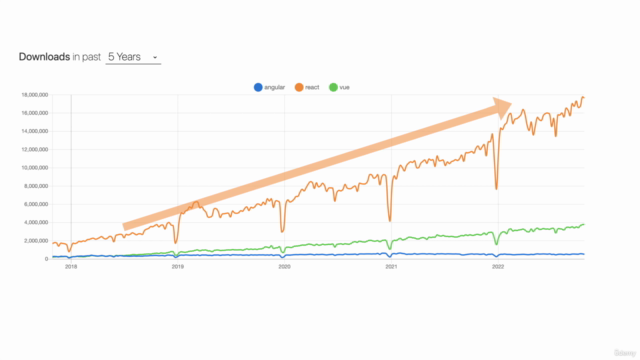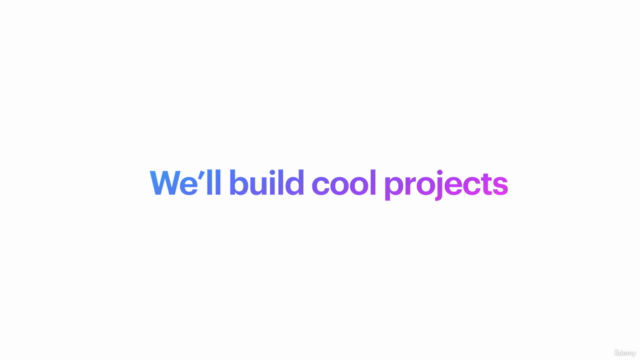React + Redux - The beginner guide. (+ Typescript )

Why take this course?
¡Hola! It's great to hear that you're looking to dive into the world of React with TypeScript, and possibly even expand your horizons to include Angular, Vue, Node.js, and Electron. This is a fantastic stack to learn, as it covers a wide range of modern web development technologies. Let's break down what you've mentioned and see how we can approach this learning journey.
React + Redux with TypeScript
React is a popular JavaScript library for building user interfaces, particularly single-page applications (SPAs). Redux is an predictable state container that helps manage the application's state in a more structured way. Combining React and Redux with TypeScript will give you strong typing throughout your application, which can greatly improve code quality and maintainability.
Here's a brief overview of what you'll cover:
- Setup: Initialize a new React project using
Create React ApporVite, and configure TypeScript. - Components: Build reusable React components.
- States: Manage application state with Redux.
- Props: Pass data between components.
- Hooks: Use built-in hooks like
useEffect,useContext,useRef,useNavigation,useRoute,useSelector,useDispatch, anduseMemo. - Contexts: Share state across many components without having to pass props down manually.
- Refs: Access DOM nodes or React elements directly.
- Forms and Validations: Handle user input through forms and ensure data integrity with validation.
- Authentication: Implement signup and login functionality using Firebase Auth.
- Firestore: Use Firestore as a real-time backend to store and sync data.
- Navigation: Route between different views in your application with React Router.
- Callbacks: Write functions that get called in response to events or asynchronous operations.
- ES6 Functions: Utilize advanced array methods like
map,reduce, andfilter. - Styling: Apply CSS, CSS modules, or frameworks like JSS or Bootstrap.
- Understanding Redux Store: Write to and read from the Redux store.
- Middleware: Enhance and transform dispatched actions with middleware like Redux Thunk or Redux Saga.
- Redux Persistence: Keep your application's state persistent, even after the user refreshes the page.
- Mock Server: Set up a fake server using Json-server for testing.
- Asynchronous Requests: Fetch data from APIs or databases asynchronously.
- Deployment: Deploy your React app on the web.
- Testing: Write tests with Jest and React Testing Library.
- Custom Hooks: Create reusable piece of stateful logic.
- Internationalization (i18n): Support multiple languages in your application.
The TypeScript Language
TypeScript is a superset of JavaScript, adding static typing to the language. It's developed and maintained by Microsoft. Here's what you'll learn:
- Primitives Types: Learn about string, number, boolean, array, tuple, enum, any, void, null, and undefined types.
- Compiler: Understand how the TypeScript compiler converts your TypeScript code to JavaScript.
- Classes: Define classes with type safety.
- Functions: Create functions with default and optional parameters.
- Objects: Use interfaces and types to describe the shape of objects.
- Arrays: Work with typed arrays.
- Object-Oriented Programming (OOP): Apply OOP principles within TypeScript.
- Namespaces and Modules: Organize your code into namespaces or modules for better maintainability.
- Interfaces: Define interfaces to describe the structure of objects, ensuring that implementing classes adhere to the specified contract.
- Enumerations (Enums): Create type-safe enums.
- Access Modifiers: Control the accessibility of class members and modules.
- Types: Declare types for variables, functions, and object properties.
- Type Casting: Explicitly convert values from one type to another.
- Generics: Write reusable component code that works with any type.
- Advanced Types: Explore advanced types like unions, intersections, conditional types, and type guards.
Beyond React: Angular, Vue, Node.js, Electron
Once you're comfortable with React and TypeScript, you can explore other frameworks and technologies within the JavaScript ecosystem:
- Angular: A platform and framework for building single-page client applications using HTML and TypeScript.
- Vue: A progressive framework for building user interfaces, often praised for its simplicity and flexibility.
- Node.js: Run JavaScript on the server side, build networking capabilities, and create RESTful APIs or GraphQL endpoints.
- Electron: Build cross-platform desktop applications with web technologies like HTML, CSS, and JavaScript.
Learning Resources
To get started, here are some resources you might find useful:
- Official Documentation: The TypeScript documentation is an excellent starting point for understanding the language features.
- React Official Documentation: Learn the fundamentals of React from the official guide.
- Redux Official Documentation: Get to know Redux by reading its documentation.
- TypeScript Cheatsheets and Guides: Use these resources to quickly reference syntax and best practices.
- Online Courses and Tutorials: Platforms like Udemy, Coursera, freeCodeCamp, and Codecademy offer comprehensive courses on React, Redux, TypeScript, and more.
- GitHub Repositories: Explore real-world projects to see how TypeScript and React are used in practice.
- Community and Support: Engage with the community through forums like Stack Overflow, Reddit's r/reactjs, or the TypeScript community on GitHub.
Conclusion
This is a comprehensive journey that will require dedication and practice. Take it one step at a time, and don't hesitate to seek help when you encounter challenges. The investment in learning these technologies will be well worth it, as they are widely used and highly regarded in the industry.
Wishing you the best of luck on your learning adventure! Remember, it's a marathon, not a sprint, so pace yourself and enjoy the process. Codiku!
Course Gallery




Loading charts...